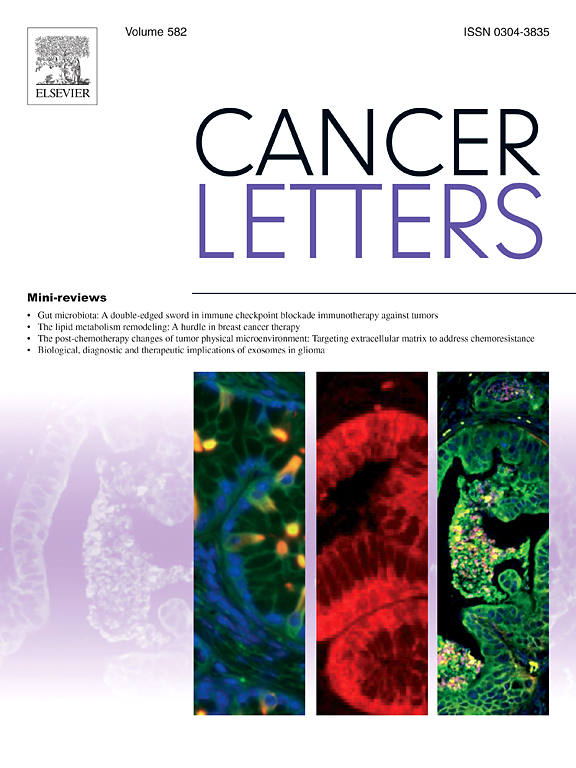Microbiome, metabolome, and ionome profiling of cyst fluids reveals heterogeneity in pancreatic cystic neoplasms
IF 9.1
1区 医学
Q1 ONCOLOGY
引用次数: 0
Abstract
Pancreatic cystic neoplasms (PCNs) carry variable malignant potential, requiring precise clinical management. However, the heterogeneity and progression of PCNs remain poorly understood. This study analyzed the microbiome, metabolome, and ionome profiles of cyst fluids from 188 patients, including 165 with PCNs and 23 with other cyst types, using PacBio full-length 16S/ITS sequencing, LC-MS/MS, and ICP-MS. Bioinformatic analyses were performed, and metabolic enzyme and endoplasmic reticulum (ER) stress-related gene expression were examined using the PAAD TCGA dataset. PCNs were classified into distinct histopathological subtypes, including mucinous cystic lesions (MCLs) and serous cystic lesions (SCLs). MCLs demonstrated lower microbial diversity compared to SCLs, indicating microbial instability. Streptococcus and Staphylococcus were identified as key taxa in intraductal papillary mucinous neoplasms (IPMNs) and mucinous cystic neoplasms (MCNs), respectively. MCLs exhibited metabolic shifts towards lipid metabolism, while IPMNs showed distinct metabolic profiles potentially reflecting inflammation-related metabolic reprogramming. Ionic diversity varied among subtypes, with MCLs showing reduced diversity and IPMNs presenting broader ionic profiles. Palmitic acid (PA), a metabolite linked to Streptococcus, may contribute to pro-inflammatory metabolic alterations in IPMN. Our preliminary experiments demonstrated that co-culturing Streptococcus orails (S. orails) with ASAN-PaCa cells promoted their proliferation, accompanied by an elevation of PA levels in the supernatant. This integrative microbiome–metabolome–ionome analysis highlights histopathological heterogeneity among PCNs. While mechanistic associations remain to be fully defined, mucinous lesions may be more susceptible to microbe-driven metabolic disruption, with Streptococcus-associated lipid alterations as a potential contributing factor.
胰腺囊性肿瘤中囊液的微生物组、代谢组和离子组分析揭示了异质性
胰腺囊性肿瘤(pcn)具有可变的恶性潜能,需要精确的临床治疗。然而,pcn的异质性和进展仍然知之甚少。本研究使用PacBio全长16S/ITS测序、LC-MS/MS和ICP-MS分析了188例患者的囊肿液的微生物组、代谢组和离子组谱,其中包括165例PCNs和23例其他类型的囊肿。进行生物信息学分析,并使用PAAD TCGA数据集检测代谢酶和内质网(ER)应激相关基因表达。pcn分为不同的组织病理学亚型,包括粘液囊性病变(MCLs)和浆液囊性病变(SCLs)。与scl相比,mcl的微生物多样性较低,表明微生物不稳定。在导管内乳头状黏液性肿瘤(IPMNs)和黏液性囊性肿瘤(MCNs)中,链球菌和葡萄球菌分别被确定为关键分类群。mcl表现出向脂质代谢的代谢转变,而IPMNs表现出不同的代谢谱,可能反映了炎症相关的代谢重编程。离子多样性在不同的亚型中有所不同,mcl的多样性降低,而ipmn的离子谱更宽。棕榈酸(PA),一种与链球菌相关的代谢物,可能有助于IPMN的促炎代谢改变。我们的初步实验表明,与ASAN-PaCa细胞共培养的轨道链球菌(S. orails)促进了它们的增殖,并伴随着上清中PA水平的升高。这种综合微生物组-代谢组-离合组分析强调了pcn之间的组织病理学异质性。虽然机制关联仍有待完全确定,但粘液病变可能更容易受到微生物驱动的代谢破坏,而链球菌相关的脂质改变是一个潜在的促成因素。
本文章由计算机程序翻译,如有差异,请以英文原文为准。
求助全文
约1分钟内获得全文
求助全文
来源期刊

Cancer letters
医学-肿瘤学
CiteScore
17.70
自引率
2.10%
发文量
427
审稿时长
15 days
期刊介绍:
Cancer Letters is a reputable international journal that serves as a platform for significant and original contributions in cancer research. The journal welcomes both full-length articles and Mini Reviews in the wide-ranging field of basic and translational oncology. Furthermore, it frequently presents Special Issues that shed light on current and topical areas in cancer research.
Cancer Letters is highly interested in various fundamental aspects that can cater to a diverse readership. These areas include the molecular genetics and cell biology of cancer, radiation biology, molecular pathology, hormones and cancer, viral oncology, metastasis, and chemoprevention. The journal actively focuses on experimental therapeutics, particularly the advancement of targeted therapies for personalized cancer medicine, such as metronomic chemotherapy.
By publishing groundbreaking research and promoting advancements in cancer treatments, Cancer Letters aims to actively contribute to the fight against cancer and the improvement of patient outcomes.
 求助内容:
求助内容: 应助结果提醒方式:
应助结果提醒方式:


